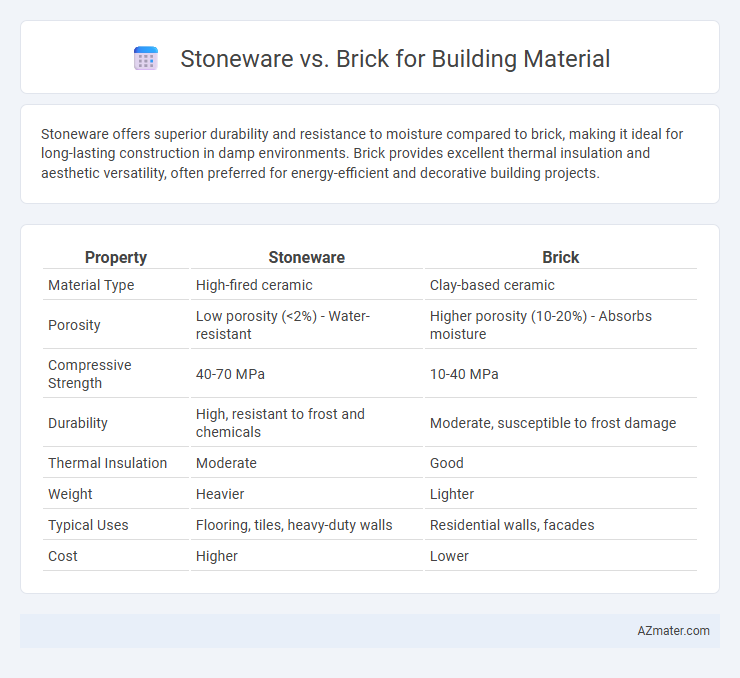Stoneware offers superior durability and resistance to moisture compared to brick, making it ideal for long-lasting construction in damp environments. Brick provides excellent thermal insulation and aesthetic versatility, often preferred for energy-efficient and decorative building projects.
Table of Comparison
| Property | Stoneware | Brick |
|---|---|---|
| Material Type | High-fired ceramic | Clay-based ceramic |
| Porosity | Low porosity (<2%) - Water-resistant | Higher porosity (10-20%) - Absorbs moisture |
| Compressive Strength | 40-70 MPa | 10-40 MPa |
| Durability | High, resistant to frost and chemicals | Moderate, susceptible to frost damage |
| Thermal Insulation | Moderate | Good |
| Weight | Heavier | Lighter |
| Typical Uses | Flooring, tiles, heavy-duty walls | Residential walls, facades |
| Cost | Higher | Lower |
Introduction to Stoneware and Brick as Building Materials
Stoneware is a durable, non-porous ceramic material fired at high temperatures, making it resistant to water and weathering, ideal for outdoor construction and decorative masonry. Brick, composed primarily of clay or shale and fired to harden, offers excellent compressive strength, thermal mass, and longevity, widely used in load-bearing walls and facades. Both materials provide unique structural and aesthetic benefits, with stoneware emphasizing moisture resistance and brick focusing on versatility and strength in building applications.
Composition and Manufacturing Process
Stoneware is composed primarily of refined clay fired at high temperatures between 1200degC and 1300degC, resulting in a dense, non-porous ceramic material with high durability and resistance to water. Brick is typically made from natural clay or shale mixed with sand and other additives, shaped and fired at lower temperatures ranging from 900degC to 1100degC, which creates a porous and less dense material. The manufacturing process for stoneware involves a longer, more controlled firing cycle and vitrification that imparts superior mechanical properties, while brick production focuses on molding and standard firing for scalability and cost-effectiveness.
Durability and Longevity Comparison
Stoneware offers superior durability due to its high density and resistance to weathering, making it an excellent choice for long-lasting construction. Brick, while also durable, tends to absorb more moisture and may require more maintenance over time to prevent cracking and erosion. The longevity of stoneware typically surpasses brick by decades, especially in harsh climates where exposure to freeze-thaw cycles and heavy rain is frequent.
Strength and Structural Integrity
Stoneware offers high compressive strength and excellent durability, making it resistant to weathering and structural stress. Bricks, especially fired clay bricks, provide consistent strength with good tensile properties, contributing to stable load-bearing walls. Both materials ensure strong structural integrity, but stoneware typically excels in longevity and resistance to environmental degradation.
Insulation and Thermal Properties
Stoneware offers superior insulation and thermal mass compared to brick, maintaining stable indoor temperatures by absorbing and slowly releasing heat. Brick provides decent thermal insulation but typically has higher thermal conductivity, causing quicker heat transfer and less effective energy efficiency. Stoneware's denser composition enhances its ability to reduce heat loss and improve energy conservation in buildings.
Aesthetic Appeal and Design Flexibility
Stoneware offers a sleek, contemporary aesthetic with smooth textures and uniform color, ideal for modern architectural designs. Brick provides a classic, timeless look with natural variation in tone and texture, enhancing traditional and rustic styles. Design flexibility is greater with brick due to its range of sizes, colors, and patterns, allowing creative customization not typically available with stoneware.
Cost and Availability
Stoneware offers durability and a unique aesthetic but tends to be more expensive and less readily available compared to bricks, which are widely produced and affordable. Bricks provide a cost-effective solution with consistent supply, making them a popular choice for large-scale construction projects. Availability of local clay deposits influences the cost-effectiveness of both materials, with bricks often benefiting from established manufacturing infrastructure.
Environmental Impact and Sustainability
Stoneware offers superior durability and requires less frequent replacement compared to brick, reducing long-term environmental impact through resource conservation. Bricks, often made from clay, typically involve high energy consumption during firing, contributing to greater carbon emissions. Utilizing locally sourced stoneware or reclaimed bricks can significantly enhance sustainability by minimizing transportation emissions and promoting material reuse.
Maintenance and Weather Resistance
Stoneware provides superior weather resistance due to its dense, non-porous surface that resists moisture, frost, and temperature fluctuations, reducing the risk of cracking and erosion over time. Brick requires regular maintenance like sealing and repointing to prevent water infiltration and freeze-thaw damage, which can lead to spalling and structural weakening. Stoneware's low maintenance needs combined with its durability make it a more resilient choice in harsh climatic conditions compared to brick.
Best Applications: When to Choose Stoneware or Brick
Stoneware excels in applications requiring high durability and resistance to moisture, making it ideal for outdoor landscaping, drainage pipes, and high-temperature environments such as fireplaces. Brick is preferred for structural elements like walls and facades due to its excellent compressive strength, insulation properties, and aesthetic versatility in residential and commercial construction. When selecting between the two, prioritize stoneware for weather-resistant and wear-intensive uses, while brick suits load-bearing and decorative architectural projects.

Infographic: Stoneware vs Brick for Building Material
 azmater.com
azmater.com